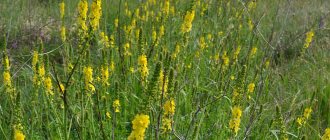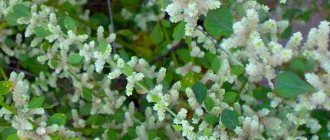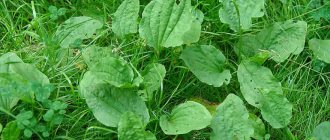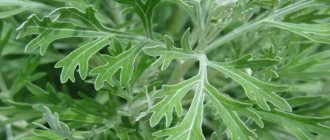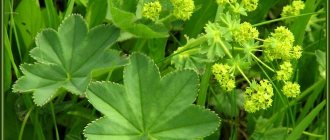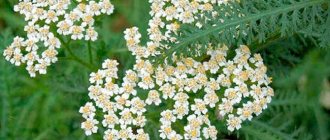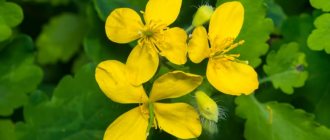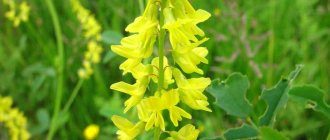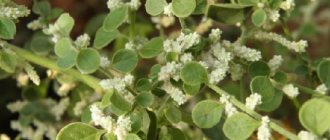The article was prepared by a specialist for informational purposes only. We urge you not to self-medicate. When the first symptoms appear, consult a doctor.
Thermopsis is a foul-smelling perennial plant with long creeping rhizomes and a simple, erect stem. This herbaceous plant has trifoliate, grayish-green, lanceolate-shaped leaves. The leaf blades are supplemented with large stipules. Large yellow flowers of irregular shape are collected in graceful clusters. The thermopsis fruit is a linear bean with a small spout.
This unique plant blooms in June and July. Around August, the seeds begin to ripen. Thermopsis is found in the Volga region and in the steppe regions of southwestern Russia. It prefers saline damp meadows, grassy slopes, fields and steppes.
Useful properties of thermopsis
The presented herb contains large quantities of substances useful to humans, esters and alkaloids. Various preparations based on thermopsis have a powerful expectorant effect. The tannins and saponins contained in the grass have quite diverse effects on the human body. Such a plant can increase blood pressure, stimulate appetite, increase the tone of the uterus and inhibit the nodes of the autonomic nervous system. Thanks to anagarine, the herb has curare-like properties.
In modern medical practice, various preparations containing thermopsis are used as an expectorant and anti-inflammatory agent for various colds and infectious diseases. Healing infusions of the herb promote rapid removal of mucus from the respiratory tract, stimulate breathing and relieve spasms of peripheral blood vessels. In addition, thermopsis is indicated for hypotension, as well as for stimulating weak labor. The powder of this dry plant produces an insecticidal effect.
Herbs such as thermopsis have been proven to be effective as an anthelmintic. Modern doctors prescribe the herb not only for pneumonia and bronchitis, but also for fever, flu, headaches and intestinal atony.
Reproduction
Thermopsis can be propagated in two main ways - vegetative and seed. The second method is used as the most common. In the case of vegetative propagation, the method of dividing the rhizome and root shoots is used. Each of the above methods has its own characteristics.
Seed propagation
The simplest and most common way to obtain new crops is considered to be seed propagation. For greater decorative value in the first year of planting, gardeners recommend growing thermopsis from seedlings. Sowing is carried out in February, in small containers filled with nutrient soil. Before placing the seeds in the soil, it is moistened. The seeds are evenly distributed over the surface of the substrate, after which the container is covered with film to create greenhouse conditions. The containers are placed in a bright, warm place. For greater germination, containers are regularly ventilated.
With proper care, the first seeds germinate within 1-2 months after sowing. After this, the crop is gradually accustomed to fresh air, opening the film more and more. After getting used to it, the plants become completely bare. With the onset of constant warmth, the seedlings are picked and placed in a permanent place of growth.
Propagation by root suckers
In order to get several new bushes, the mother's adult bushes can be divided in spring or autumn. To do this, the crop is carefully dug up and cleaned of soil residues. For high-quality propagation, the mother is divided into equal parts so that the rhizome remains on all divisions. For painless transfer of division, all damaged parts of the rhizome on the divisions are treated with root. The resulting parts are planted in a permanent habitat, watered abundantly with water until rooting.
Application of thermopsis
All kinds of herbal infusions and decoctions have a pronounced stimulating effect on the removal of phlegm. It is manifested by increased secretory functions of the bronchial glands, accelerated evacuation of secretions and increased activity of the smallest ciliated epithelium, as well as increased smooth muscle tone due to the vagotropic effect.
Thermopsis is indicated for both adults and children. It is no coincidence that it is part of many complex medicinal teas and herbal mixtures. For chronic bronchitis and pneumonia, it is difficult to do without such a universal remedy. To prepare an infusion of 6 mg of herb, take one glass of boiling water and infuse the product for about eight hours. Adults should take it up to 5 times a day, 1 tablespoon. The children's dosage is 1 tablespoon no more than three times a day.
Thermopsis preparations are often prescribed for low blood pressure; at the same time, due to special adrenergic mechanisms of action, they also enhance the function of the adrenal glands. It should also be noted that the plant has ganglion-blocking properties. When prescribing medicinal preparations based on thermopsis, it is recommended to be careful, since thermopsis is considered a potent substance.
Preparation and storage
For medicinal purposes, thermopsis grass is used, which is harvested during the growing season of the crop. With the beginning of budding and flowering, the above-ground parts of the plant are collected. The resulting materials are dried on a flat surface in the shade, with good ventilation. You can also prepare the material in special dryers. After drying the herb, it is recommended to immediately chop it up and place it in a jar for storage. The plant is also stored in paper and fabric bags. The optimal shelf life is one year.
Thermopsis for cough
Popular cough tablets based on thermopsis have been successfully used for decades, despite the availability of more modern medications. This wonderful expectorant is indicated for various ailments of the bronchopulmonary system.
When taken orally, these tablets are absorbed in the gastrointestinal tract itself, and then instantly enter the bloodstream and the mucous membrane of the trachea and bronchi, producing a powerful irritating effect. This causes reflex secretion of thick bronchial secretions. The motor activity of the bronchial muscles also increases, which promotes expectoration and complete removal of pathogenic sputum.
Thanks to the sodium bicarbonate included in the tablets, they significantly reduce the viscosity of sputum. Thermopsis is indicated for non-productive dry cough.
How to take thermopsis? For bronchitis and pneumonia, as well as for acute inflammatory diseases of the respiratory tract, adults are prescribed to take the medicine 3 times a day, one whole tablet. The course of treatment should be at least three days. For prolonged or chronic inflammation, the course is extended to 5 days.
Thermopsis for cough for children. Up to two years of age, it is recommended to give children an infusion of herbs, which is prepared at the rate of 0.1 grams of raw material per 100 ml of boiling water. The medicine should be taken half a teaspoon no more than three times a day. For children under 6 years old, you can increase the dose of infusion to 1 teaspoon. Children from 6 to 12 years old are prescribed a course of treatment of 0.5 tablets. To get results, you should take the medicine regularly for at least three days.
Care
Growing thermopsis in your own area is quite simple. The culture is highly unpretentious to growing conditions, which allows it to be cultivated in various areas, including infertile ones. An important condition for cultivation is proper care of the plant and compliance with planting rules.
Before planting thermopsis, it is important to prepare the soil. The cultivation site must be carefully dug and loosened. Immediately before planting, moisten the soil with warm, settled water. Planting is carried out in the spring, after the snow melts and the onset of constant warmth. The material used is seedlings or seeds, which will also take root quite easily in the nutrient medium. The plant takes root even in depleted soil, so it is not necessary to specifically select the soil composition. If the soil contains heavy elements, most of the sand or peat is added to it before planting. Immediately after planting, the grass growing area is mulched to maintain the necessary soil moisture for a long time.
Illumination
It is necessary to plant thermopsis in a sunny and shaded place. As an ornamental crop, to obtain lush and long-lasting flowering, lighting plays a decisive role in the development of thermopsis. The plant also develops well in partial shade, but in this case the abundance of foliage and the shape of the bush suffer, since the thermopsis begins to stretch upward.
Watering
It is important for the crop to constantly maintain soil moisture. In drought conditions, thermopsis is watered regularly. In addition, to maintain soil moisture, it is recommended to make a layer of mulch under the plant from loose peat or dry leaves. It is important not to over-moisten the soil to prevent rotting of the rhizome.
Humidity
In the wild, the plant is often found along the banks of water bodies, since air humidity is high in this place. When cultivating in garden conditions, it is important to provide the plant with comfortable conditions, including maintaining moisture in the air. To do this, regularly spray the crop or cultivate thermopsis near artificial reservoirs.
Fertilizer
When cultivating perennials, they rarely use any fertilizers. This is due to the fact that thermopsis easily takes root and is cultivated on depleted soils. However, when grown for decorative purposes, mineral complexes are added to the crop once a year in order to preserve and increase the decorativeness of the grass, increase the number of ovaries and form a lush crown of bushes.
You may be interested in: Beautiful lavender - planting and care, review of popular types and varieties
soil mixture
Thermopsis prefers very loose and nutritious soil, which has a sufficient drainage layer. Despite the fact that it is easy to grow the crop in both sand and clay, thermopsis will respond with gratitude if the substrate is well selected. To keep the plant in a healthy state, when cultivating the soil, some sand, peat and humus are added to it.
Bloom
Thermopsis blooms in the summer months. The plant forms long stalks from the axils of the leaves. Brushes consisting of 5-10 flowers appear at the ends of the peduncles. The flowers are cup-shaped, usually yellow or orange. Flowering continues for 1-2 months. The flowers have a strong smell and are unpleasant to perceive.
Transfer
Thermopsis acutely and painfully endures various movements from place to place. Therefore, it is necessary to cultivate the plant in its new place only if necessary. During a forced transplant, many gardeners recommend taking as much of the earthen clod around the crop as possible so as not to disturb the thermopsis as much as possible. Immediately after transplantation, the plant is watered abundantly. Regular watering is observed until the thermopsis takes root in a new place.
Thermopsis infusion
Thermopsis infusion is known for its expectorant properties. In large dosages, it often leads to a gag reflex. By increasing the secretion of mucus in the respiratory airways, it significantly increases the own contractility of the bronchi. Stimulation of smooth muscles ensures the removal of phlegm. Along with this, thermopsis infusion increases blood pressure. It is worth mentioning the strong ganglion-blocking properties of the presented drug.
To independently prepare the presented herbal infusion, you will need at least 200 grams of water per 1 gram of dried herb. It is recommended to infuse the product for about 40–50 minutes, and then strain. The dosage for an adult should not exceed 1 tablespoon; you can drink the drug up to 4 times a day.
Diseases and pests
As a rule, thermopsis is not subject to attack by pests and various pathologies, however, in some cases, violations of quality and care can lead to various pathological abnormalities. Rotting of the rhizome is considered one of the common diseases of the crop. The cause of the disease is excessive watering and lack of a drainage layer, which lead to the roots being constantly in water. To eliminate the pathology, watering is stopped until the soil dries, and the thermopsis is taken out of the soil and the rotten roots are removed. It is also recommended to treat the roots with a fungicidal agent. Otherwise, the plant is poisonous, so it is not attacked by insects.
Thermopsis lanceolata
Thermopsis lanceolata is an unusual herbaceous plant, the height of which varies from 10 to 45 cm. The presented perennial has long creeping roots and thin, few roots. Straight, few-branched stems have light grooves and pubescence before flowering. The trifoliate alternate leaves are on the petioles. Their elliptical shape and solid edge make the leaf blades elegant. Young leaves are always densely pubescent and folded.
The thin apical raceme represents the inflorescence. The flowers are located on short stalks in the axils of the bracts. The small bean, about 5 cm long, has a linear, protruding seed receptacle. When the fruit valves open, kidney-shaped, smooth seeds with a bluish-black coating appear. Lanceolate thermopsis blooms in June and early July. This species can be found in Siberia and Kazakhstan. As a rule, this plant chooses saline and sandy soils. It settles in river valleys, on small gravelly slopes, and also in wheat crops.
Spreading
It is quite easy to find thermopsis in the wild, because the culture is widespread in many countries. The habitat of thermopsis in its natural environment is North America and central Asia. In Russia, you can find wild growing habitats in Siberia and the Far East. The culture is popular in China and Japan. In its natural environment, thermopsis grows on mountain slopes, meadows and bright sunny places.
Despite the fact that the culture is not so widespread in the natural environment, it is grown as an economic and medicinal plant. You can find domesticated species almost everywhere, including in Russia. To grow a crop, you need nutritious soil and a high-quality soil composition.
Contraindications to the use of thermopsis
The main contraindications to the use of this plant include hypersensitivity and ulcerative conditions of the stomach and duodenum. In case of overdose, vomiting may occur.
Author of the article:
Sokolova Nina Vladimirovna |
Herbalist Education: Diploma in General Medicine and Therapy received from the University named after N.I. Pirogov (2005 and 2006). Advanced training at the Department of Herbal Medicine at the Moscow People's Friendship University (2008). Our authors
Wintering
Since thermopsis easily tolerates any cold in the wild, you don’t have to think about this issue when cultivating the plant in gardens and parks. The plant easily adapts to any weather conditions and tolerates cold. Some species require pruning of the aerial parts after the fruits ripen. The optimal temperature for wintering the crop is considered to be 25 degrees below zero. If the temperature drops further after snow falls, the bushes are covered with snowdrifts to maintain the soil temperature.
Botanical description of the plant
Lanceolate thermopsis (in Latin - Termopsis Lanceolata), belongs to the legume family. The plant is perennial, with a long creeping rhizome, up to 40 centimeters high. The stem is ribbed to the touch and covered with hairs.
The content of the article
- Botanical description of the plant
- Chemical composition of the plant
- Medicinal properties and uses
- Medical preparations from thermopsis
- Possible harm, contraindications, side effects
The leaves are alternate, trifoliate, linear-oblong, pubescent with white hairs. Up to 7 cm long and up to 1.5 cm wide.
And the flowers are yellow, large, like moths, collected in a raceme inflorescence. Apical sours grow up to 17 cm long. The flowers are arranged oppositely or collected in whorls. Perianth or bract up to 2 cm long. The yellow corolla is up to 3 cm long; at the end of flowering it forms a fruit - a bean up to 9 cm in length. Inside the bean, up to 14 seeds (peas), up to 4 mm in diameter, black in color, develop.
The plant is a weed, considered in many places to be a difficult to eradicate weed. But its large yellow flowers delight the eye and decorate the surrounding steppe landscape. Thermopsis blooms in June - July.
This is a typical steppe plant, familiar to everyone who lives in Eastern and Western Siberia.
Spreading . Under natural conditions, it also grows in the Tien Shan Mountains, Kyrgyzstan and Kazakhstan. In the European region of our country it is found in the Volga region. Loves sunny meadows with sandy soils, chooses dry gentle slopes. It can grow in crops like a weed.
Walking to the dacha, I saw a yellow meadow of brightly blooming thermopsis on the outskirts of the city, next to the forest. Bright yellow spots were visible from a distance. Look at the photo, how beautiful it is - a poisonous weed, Thermopsis lanceolata.
Harvesting grass, drying raw materials
Like many poisonous plants, thermopsis is a healing plant. The entire grass with flowers, leaves and seeds is harvested from thermopsis. The grass is collected during flowering, cutting off the stem 3-4 centimeters above the root collar.
Thermopsis should be dried immediately after cutting, in a well-ventilated area, under a canopy or in the attic. Dry in dryers at temperatures up to 60 degrees.
The seeds are collected from September, the beans are threshed, aerated and dried, just like the grass. When drying grass and seeds, care must be taken, since thermopsis is a poisonous plant. The shelf life of raw materials is up to two years.
Interesting Facts
Thermopsis is capable of growing quickly, so if not cared for well it tends to run wild. The toxicity of this plant leads to the endowment of other garden crops with this property. Therefore, when a crop is discovered in a garden or bed in its wild form, the grass is quickly disposed of.
The plant is often used to prepare poison for rodents. The method has been in effect for a couple of centuries and is highly effective. To prepare the poison, thermopsis is mixed with bread crumbs and placed in a rodent habitat.

